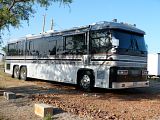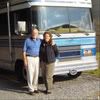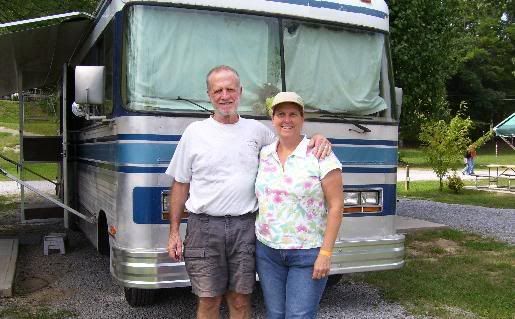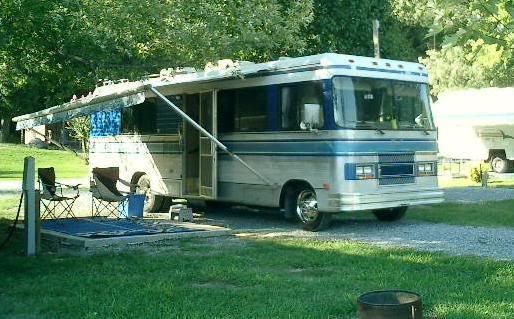Go to...  | Start A New Topic  | Search  | Notify  | Tools  | Reply To This Topic  |  |
 3/23 3/23 |
Other recommendations, with cost constraints(15-30K), welcomed. | ||
|
 12/10 12/10 |
The start of this year, I was out searching for a motorhome. I spent 3 months tooling around AZ, CA and NV. I was looking at Revcons. What a cool coach but everything I looked at were either out of my price range or rolling wrecks. Some couldn't even qualify as rolling. Check them out, aluminum contruction, front wheel drive, great support community too. Well not as great as Barthmobile...that is the gold standard right there but I admit I'm biased. I have a friend with a GMC who I tease all the time. "WOW, nice Revcon knockoff ya got there!" Regal 25 built in 1989 1985 P-30 chassis 454 TH400 | |||
|
You're exactly right. The Revcon is a fabulous piece of machinery. I remembered the first 1979 REvcon I saw. THere was such a difference between a 1979 REvcon and a 1979 Winnebago. My parents had one 20 years ago and it handled well and road well. BUT it is an extremely complicated coach. I really wanted one but the more I researched it, the more I was scared away. There are always issues with traction with a front wheel drive coach (we had a FWD Travoy, FWD GMC and FWD Revcon..it could get fun getting stuck on the sands of a Texas beach)You have quite a complicated system with the front wheel drive...the torsion bar suspension and the associated parts of front wheel drive system...bellcranks to name a few... Also, there is the problem with the "compactness" of the front wheel drive platform. Not as much storage inside or out..... the interior space is compromised by the great curved exterior lines of the coach also...kind of like the Airstream. Another reason for me was the Revcon website didn't give much help....talking with some of the oldtimers, it maybe did 10 or 15 years ago but nowadays there were only a handful of people who knew the coaches. BARTHMOBILE was one of the main reasons I went ahead and bought my Barth. Great coach, easy to work on and maintain, lots of storage room, and a great group of helpful people. | ||||
|
FKA: noble97monarch 3/12 3/12 |
Just because it is framed with metal does not make it of Barth quality. Many fiberglass RVs used steel (untreated or poorly treated) then bonded the fiberglass outside and luan inside. The result is often completely rotted out metal framing due to moisture being trapped in the sandwich. In my view this is no better than stick and staple. Later model fiberglass units (generally 2002 and newer) used a vacuum formed panel technique that claims to eliminate the moisture issues. The problem, of course, is that it takes years verify the claim. In my own quest for the superior RV structure, I have owned four Diesel Pushers, all quite different. None have been fiberglass and none have had a slide. To me this is a great start to insuring integrity. Barth will give you a production chassis, aluminum house framing and aluminum sides. The beauty of this construction is that when you get an inevitable leak, it will only do cosmetic damage even if not caught quickly. The Europremier cannot claim that. As far as ride, power, and appointment they are probably comparable. Newell is as close to a Barth as there is, but builds their own chassis using a balloon framing similar to commercial buses. The ride is superior and the storage is greater. Newell builds their frames from square tube steel which could have corrosion issues over time, although they may be better treated than I have been able to verify. The "Busses" - Prevost, MCI, Bluebird are all bus companies that build their chassis in a balloon construction, but using much more stainless steel and galvanized/powder coating to combat corrosion. Of these three only Bluebird built a dedicated motorhome chassis, the Wanderlodge. The others only build the commercial chassis which is then converted by many different companies over the years. A big dilemma - In recent times (the last 20 years) the Newell and buses have been pretty exclusively built in the 40+ foot range. If your looking for a DP in 35 or less, I can only recommend a Barth, an aluminum Beaver, or an aluminum Trek. In an older rig, prior to 85, you might find a smaller Wanderlodge or Newell. Other considerations - a) Is the power adequate (many DPs are underpowered) b) Is the suspension adequate (this forum has proven to me that many DPs are built to their weight limit, or beyond) c) Is it easily serviceable, I found out the hard way how tough it is to service a defective generator that didn't have a slide out in my Barth! I know you are a boater, do not confuse boat fiberglass hull engineering to RV fiberglass. They are completely different. To continue a little with the boat comparisons, no fiberglass sided class A has yet proven itself to be above Bayliner quality in my eyes to date. On possible exception would have been the GMC (or Revcon) motorhomes if they got the driveline right, but they didn't. These are my highly controversial opinions only.  Formerly: 1997 Barth Monarch Now: 2000 BlueBird Wanderlodge 43' LXi Millennium Edition DD Series 60 500HP 3 stage Jake, Overbuilt bike lift with R1200GS BMW, followed by 2011 Jeep Wrangler Unlimited, “I haven’t been everywhere, but it’s on my list.” | |||
|
| First Month Member |
We looked at Revcons. They were high quality, but I didn't want an elderly low production FWD vehicle. The later ones had a prettier front end and a 454 Chev. The Olds in the earlier ones was either a 403 or a 455, depending on year. I was thinking of buying a particular one with a sick 403 and putting in a spare 455 Olds I had at the time. The Olds 455 is a wonderful tow or RV engine. My Olds 455 tow car was better than several friends' 454 trucks, at least when towing ski boats. I built up a 403 so it was pretty good, but it didn't have the torque that the long stroke 455 had. Susan killed the deal over the Revcon's lack of storage space. Couples doing shorter duration trips might like it better. . 84 30T PeeThirty-Something, 502 powered | |||
|
 |
Here is an informative excerpt from NewellClassic.com by a member of the Newell team responding to a question regarding frame / chassis construction. ------------- TechTalk Senior Member Join Date: Feb 2008 Posts: 173 This is a complicated question. To start, there is no agreed definition of "full monocoque" or "semi-monocoque." Newell uses a combination of welded steel framing from the floor down and rivited aluminum framing above the floor, with the majority of the load carried by a wide steel channel going front to back in the center just under the floor (the top of the chassis). This construction is certainly some form of moncoque, rather than body-on-frame, but a hybrid to be sure. The typical bus shell extends the steel structure above the floor and across the top, with the majority of the load carried in truss like structures running front to back between the windows and the floor. Without question, this is full monocoque. When Mr. Newell designed his structure in about 1970, his goal was for the chassis to be "self supporting," not relying on the coach body, specifically the sidewalls, for support. He wanted to be able to locate doors, windows, furnace vents, etc. (slide-outs!) anywhere required without losing the structural integrity of the vehicle. By the same token, Newell solidly and permanently attaches the body structure to the chassis so that the finished unit has the much of the structural advantage of a monocoque without depending on the walls for strength. Cutting slide-outs into the walls effects the structure of both a Newell and a bus, but not as much with the Newell since the majority of the load is carried by the center channel under the floor. Hence Newell has required only a small amount of structural upgrading to go to four slides, while buses are typically limited to only two slides. We would not agree that the chassis/frame design has been greatly compromised in either case. __________________ TechTalk 1987 Newell ~ 40ft Widebody 2x f/o's: 1988 Barth - 33 Ft. SE tag axle & 1976 Barth - 24 Ft. | |||
|
 |
And a picture of the bare chassis of a 90 Newell  1987 Newell ~ 40ft Widebody 2x f/o's: 1988 Barth - 33 Ft. SE tag axle & 1976 Barth - 24 Ft. | |||
|
FKA: noble97monarch 3/12 3/12 |
Wow, some great information! The Newell has always been hard for me to research for whatever reason. One question that has defied a full answer has to do with the square tube steel under-frame. What does Newell do to protect these members? Being from the Northeast I'm all too familiar with the insidious nature of road salt. One of the great buses of all time, the Eagles, have been plagued with corrosion issues due to the nature of tubular steel to rot from the inside out. Please - please don't think I'm dissing anything here. I'm really just trying to learn the pros and cons of each of the different manufacturing techniques and material choices. I've always tried to be "agnostic" concerning brands. There are always trade offs.  Formerly: 1997 Barth Monarch Now: 2000 BlueBird Wanderlodge 43' LXi Millennium Edition DD Series 60 500HP 3 stage Jake, Overbuilt bike lift with R1200GS BMW, followed by 2011 Jeep Wrangler Unlimited, “I haven’t been everywhere, but it’s on my list.” | |||
|
 6/12 6/12Formally known as "Humbojb"  |
Corey, you have a legitimate issue. Even on the Barth, the lower storage compartments and aluminum sheet metal are supported by steel tubing. Barth put some kind of material between the steel and the aluminum but a galvanic reaction occurred anyway. I have had to replace many sections of the steel tubing on my '85 Regal. The big steel beams of the basic chassis are really not an issue. There's so much steel there, that even moderate rust can be fixed without damaging the structural integrity of the chassis. But even galvanized steel tubing, exposed to the elements of the road, will rust. Even the 400 series of stainless steel will rust. The 300 series of stainless don't have the strength of the 400 series, but will not rust as fast as the 400 series. Regardless, using stainless would be cost prohibitive. Now if someone made the whole chassis out of aluminum, that would be interesting. Probably wouldn't be strong enough.
| ||||||||||||
|
 3/11 3/11 |
The point about the steel tubing is correct. But in the Barth the repair is somewhat easier because we can drill out the rivets and remove the tubing without disrupting the strength or integrity of the coach sides. On mine and my brothers '84 we welded up replacement sections, had them powder coated, welded them in place with a TIG welder and then coated them with cold zinc spray and re-attached the skin. We decided the 5 mil zinc spray would outlast Duct tape that they used as insulators and then just drilled new holes through the existing skin and pop riveted them in place with sealed end aluminum rivets. The whole procedure was done one section at a time and the only evidence of repair is the aluminum head of the rivet, which we just ignore. Mine was worse in the engine compartment while his was along the underside of the basement compartments. The powder coating and zinc will certainly outlast both of us. 1993 32' Regency Wide Body, 4 speed Allison Trans, Front Entry door, Diamond Plate aluminum roof & 1981 Euro 22' w Chevy 350 engine and TH 400 tranny | |||
|
FKA: noble97monarch 3/12 3/12 |
To paraphrase an old saying "Corrosion never sleeps". It is so cool to see things here in Florida that have not succumbed to the ravages of rust, but even that is not a given as some people will drive into the salt water or living near the coast with salt air. I recall growing up in Maine that it was a race which would rust through first, the windshield pillars or the rocker panels!  Formerly: 1997 Barth Monarch Now: 2000 BlueBird Wanderlodge 43' LXi Millennium Edition DD Series 60 500HP 3 stage Jake, Overbuilt bike lift with R1200GS BMW, followed by 2011 Jeep Wrangler Unlimited, “I haven’t been everywhere, but it’s on my list.” | |||
|
FKA: noble97monarch 3/12 3/12 |
Is there a worry that the zinc is conductive and will allow electrolysis? I almost wonder if the spray on rubberized stuff might be better to insulate electronically. Or better yet, both.  Formerly: 1997 Barth Monarch Now: 2000 BlueBird Wanderlodge 43' LXi Millennium Edition DD Series 60 500HP 3 stage Jake, Overbuilt bike lift with R1200GS BMW, followed by 2011 Jeep Wrangler Unlimited, “I haven’t been everywhere, but it’s on my list.” | |||
|
| Powered by Social Strata |
| Please Wait. Your request is being processed... |
|
This website is dedicated to the Barth Custom Coach, their owners and those who admire this American made, quality crafted, motor coach.
We are committed to the history, preservation and restoration of the Barth Custom Coach.
We are committed to the history, preservation and restoration of the Barth Custom Coach.

